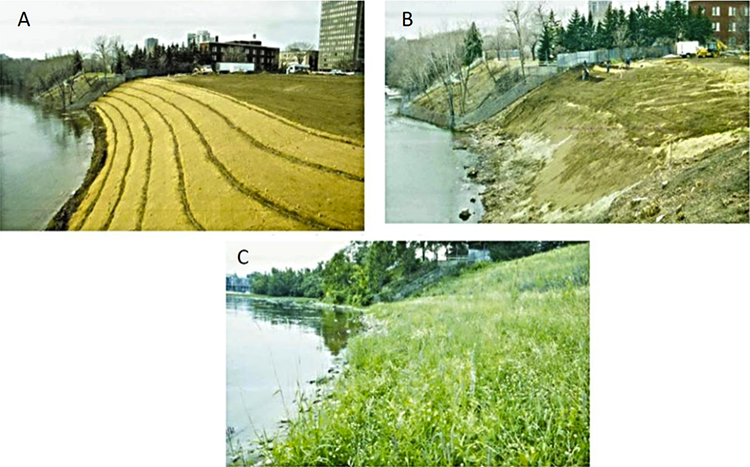Soil Bio-engineering and Streambank Stabilization
Case Study 1: Jacques-Cartier Park
Stream and riverbank protection efforts in populated areas are expected to address issues such as habitat, aesthetics, and water quality, as much as they address needs such as flood control and erosion protection. Therefore, integrated streambank protection designs that include vegetation are likely to satisfy these multiple objectives. Soil bioengineering is a method routinely used to address erosion and can be achieved in many ways across different systems. These systems utilize hybrid approaches that use geotextile fabrics and/or vegetation and can provide sound streambank protection while maximizing ecological and water quality benefits. These methods are used in place of riprap, concrete, or other inert structures alone. The Jacques-Cartier Park case study describes soil bioengineering systems that have been used to meet specific aquatic and riparian habitat objectives, and the procedures developed for this project are considered or have been used elsewhere where environmental concerns are placed high on the priority list, such as Alaska and the Ottawa River in Canada, which divides the Provinces of Ontario and Quebec.
Soil bioengineering methods have a common geotechnical benefit of providing root reinforcement in the soil and can help modify drainage patterns of the soil, help stabilize soils at steeper angles if desired, help keep grasses, and bushy vegetation in place resisting erosion, and support woody debris or other types of vegetation. The species of woody vegetation selected for inclusion in soil bioengineering systems can have a significant effect on the habitat benefits. While various species of willow are the most common woody plants used in soil bioengineering because of their excellent rooting ability, good overhanging cover and shade for streams, good nesting habitat for some species of birds, and some cover for mammals, it is not noted as an excellent food source for land animals, nor it is suitable for saline systems and may have limited applications in coastal settings.

As part of the remediation of the Jacques-Cartier Park site, contaminated soils and materials were excavated and replaced with a sand/clay subsoil mix (A) and the resulting embankment was then topped off with a new topsoil blend. The steepness of the constructed slope and the presence of the river below required using live fascines (bundles of brush) on the contour with erosion control fabric made of coir (fiber from coconut husk) to provide surface stability (B). Other project objectives for this case study included preparing a foundation where, over time, a natural community of indigenous plant materials for upland and riverine habitat would evolve, thereby improving aesthetics and establishing a long-term, maintenance-free natural slope along the Ottawa River within its highly urbanized context. The success of this project to meet the desired goals enabled Public Works to designate the area as an extension of Jacques Cartier Park (C).
Case Study 2: Waquoit Bay Preserve, Massachusetts
In this more coastal example, the Massachusetts Office of Coastal Zone Management Stormsmart Coasts Program provides guidance to property owners wishing to use bioengineering techniques to stabilize shorelines on their property. The use of a matting material made of coconut fiber called coir logs is used in combination with planting native vegetation. This is described in StormSmart Properties Fact Sheet 4: Bioengineering - Coir Rolls on Coastal Bank, a public information brochure provided to the public on the Mass.gov website. In another example, Wilkinson Engineering was employed to stabilize a shoreline on Waquoit Bay in Massachusetts. They used a variety of methods, including changing the angle of slope, installing "coir" matting to stabilize the bank, and establishing fringing marsh at the base of the slope.
Recommended Resource
Bioengineering Strategies: Reducing Coastal Erosion and Coastal Storm Damage While Minimizing Impacts illustrates the series of steps employed in bioengineering to stabilize a coastal shoreline on Waquoit Bay. Take a look at this richly illustrated document explaining the process.
